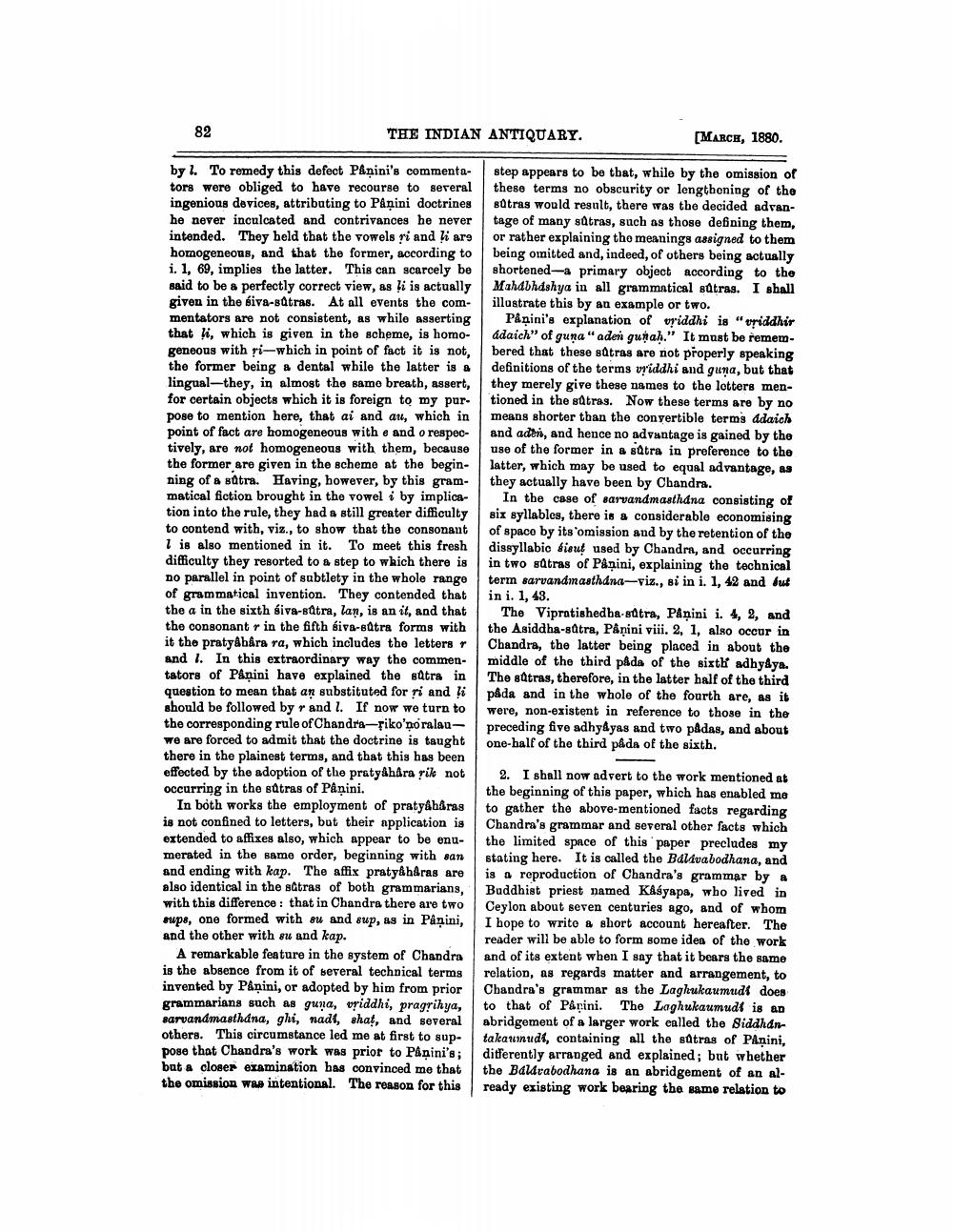________________
82
THE INDIAN ANTIQUARY.
(MARCE, 1880.
by . To remedy this defect Panini's commentators were obliged to have recourse to several ingenious devices, attributing to Panini doctrines he never inculcated and contrivances he never intended. They held that the vowels ri and li arg homogeneous, and that the former, according to i. 1, 69, implies the latter. This can scarcely be said to be a perfectly correct view, as ļi is actually given in the biva-Batras. At all events the commentators are not consistent, as whilo asserting that li, which is given in the scheme, is homo- geneous with ri-which in point of fact it is not, the former being a dental while the latter is a lingual-they, in almost the same breath, assert, for certain objects which it is foreign to my pur. pose to mention here, that ai and an, which in point of fact are homogeneous with e and o respectively, are not homogeneous with them, because the former are given in the scheme at the beginning of a sutra. Having, however, by this grammatical fiction brought in the vowel i by implication into the rule, they had a still greater difficulty to contend with, viz., to show that the consonant 1 is also mentioned in it. To meet this fresh difficulty they resorted to a step to which there is no parallel in point of subtlety in the whole range of grammatical invention. They contended that the a in the sixth Siva-sútra, lan, is an it, and that the consonant r in the fifth siva-edtra forms with it tho pratyábära ra, which includes the letters and I. In this extraordinary way the commentators of Panini have explained the satra in question to mean that an substituted for ri and ļi should be followed by r and l. If now we turn to the corresponding rule of Chandra-siko'no ralauwe are forced to admit that the doctrine is taught there in the plainest terms, and that this has been effected by the adoption of the pratyahara rilo not occurring in the stras of Pâņini.
In both works the employment of pratyaharas is not confined to letters, but their application is extended to affixes also, which appear to be enumerated in the same order, beginning with san and ending with kap. The affix pratyah&ras are also identical in the stras of both grammarians, with this difference: that in Chandra there are two sups, one formed with su and sup, as in Pånini, and the other with su and kap.
A remarkable feature in the system of Chandra is the absence from it of several technical terms invented by Paņini, or adopted by him from prior grammarians such as guna, vriddhi, pragriya, sarvandmasthana, ghi, nadi, shaf, and several others. This circumstance led me at first to suppose that Chandra's work was prior to Panini's; bat a closer examination has convinced me that the omission was intentional. The reason for this
step appears to be that, while by the omission of these terms no obscurity or lengthening of the BOtras would result, there was the decided advantage of many sátras, such as those defining them, or rather explaining the meanings assigned to them being omitted and, indeed, of others being actually shortened-a primary object according to the Mahdbhdshya in all grammatical sutras. I shall illostrate this by an example or two.
Panini's explanation of vriddhi is "vriddhir adaich" of guna "aden gunah." It must be remembered that these stras are not properly speaking definitions of the terms vriddhi and guna, but that they merely give these names to the lotters mentioned in the stras. Now these terms are by no means shorter than the convertible terms adaich and adhi, and hence no advantage is gained by the use of the former in a sutra in preference to the latter, which may be used to equal advantage, as they actually have been by Chandra.
In the case of sarvandmasthana consisting of six syllables, there is a considerable economising of space by its omission and by the retention of the dissyllabic fisut used by Chandra, and occurring in two stras of Pånini, explaining the technical term sarvandmasthana-viz., si in i. 1, 42 and but in i. 1, 43.
The Vipratishedba-sutra, Panini i. 4, 2, and the Asiddha-stra, Pånini viii. 2, 1, also occur in Chandra, the latter being placed in about the middle of the third pada of the sixth adhyâya. The stras, therefore, in the latter half of the third pâda and in the whole of the fourth are, as it were, non-existent in reference to those in the preceding five adhyâyas and two padas, and about one-half of the third pada of the sixth.
2. I shall now advert to the work mentioned at the beginning of this paper, which has enabled me to gather the above-mentioned facts regarding Chandra's grammar and several other facts which the limited space of this paper precludes my stating here. It is called the Balivabodhana, and is a reproduction of Chandra's grammar by a Buddhist priest named KAsyapa, who lived in Ceylon about seven centuries ago, and of whom I hope to writo & short account hereafter. The reader will be able to form some idea of the work and of its extent when I say that it bears the same relation, as regards matter and arrangement, to Chandra's grammar as the Laghukaumudi does to that of Parini. The Laghukaumudy is an abridgement of a larger work called the Siddhantakaumudi, containing all the stras of Panini, ditrerently arranged and explained; but whether the Baldrabodhana is an abridgement of an already existing work bearing the same relation to




